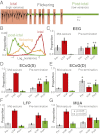Human seizures self-terminate across spatial scales via a critical transition
- PMID: 23213262
- PMCID: PMC3529091
- DOI: 10.1073/pnas.1210047110
Human seizures self-terminate across spatial scales via a critical transition
Abstract
Why seizures spontaneously terminate remains an unanswered fundamental question of epileptology. Here we present evidence that seizures self-terminate via a discontinuous critical transition or bifurcation. We show that human brain electrical activity at various spatial scales exhibits common dynamical signatures of an impending critical transition--slowing, increased correlation, and flickering--in the approach to seizure termination. In contrast, prolonged seizures (status epilepticus) repeatedly approach, but do not cross, the critical transition. To support these results, we implement a computational model that demonstrates that alternative stable attractors, representing the ictal and postictal states, emulate the observed dynamics. These results suggest that self-terminating seizures end through a common dynamical mechanism. This description constrains the specific biophysical mechanisms underlying seizure termination, suggests a dynamical understanding of status epilepticus, and demonstrates an accessible system for studying critical transitions in nature.
Conflict of interest statement
The authors declare no conflict of interest.
Figures





 , is plotted versus the bifurcation parameter C, the connection strength. At weaker connection strengths, the only attractor consists of stable limit cycles (l.c.), which correspond to large-amplitude oscillations characteristic of the ictal state (shaded light red). Increased connection strength (“C” on the x axis) induces bistability (yellow interval) in which another attractor appears, a branch of stable fixed points (f.p.). At the critical transition (blue circles) the bistability is lost and the only stable attractor becomes the branch of fixed points (shaded green). (D) Proportion of variance vectors classified as preictal (gray), ictal (red), and postictal (green) in an intermediate-connectivity (mid-seizure) and high-connectivity (pretermination) state for the population of mean-field oscillators. Flickering manifests in the pre-termination interval as significant changes in the proportions of ictal and postictal classifications.
, is plotted versus the bifurcation parameter C, the connection strength. At weaker connection strengths, the only attractor consists of stable limit cycles (l.c.), which correspond to large-amplitude oscillations characteristic of the ictal state (shaded light red). Increased connection strength (“C” on the x axis) induces bistability (yellow interval) in which another attractor appears, a branch of stable fixed points (f.p.). At the critical transition (blue circles) the bistability is lost and the only stable attractor becomes the branch of fixed points (shaded green). (D) Proportion of variance vectors classified as preictal (gray), ictal (red), and postictal (green) in an intermediate-connectivity (mid-seizure) and high-connectivity (pretermination) state for the population of mean-field oscillators. Flickering manifests in the pre-termination interval as significant changes in the proportions of ictal and postictal classifications.

References
-
- Schindler K, Elger CE, Lehnertz K. Increasing synchronization may promote seizure termination: Evidence from status epilepticus. Clin Neurophysiol. 2007;118(9):1955–1968. - PubMed
-
- Kullmann DM, Semyanov A. Glutamatergic modulation of GABAergic signaling among hippocampal interneurons: Novel mechanisms regulating hippocampal excitability. Epilepsia. 2002;43(Suppl 5):174–178. - PubMed
Publication types
MeSH terms
Grants and funding
LinkOut - more resources
Full Text Sources
Medical

